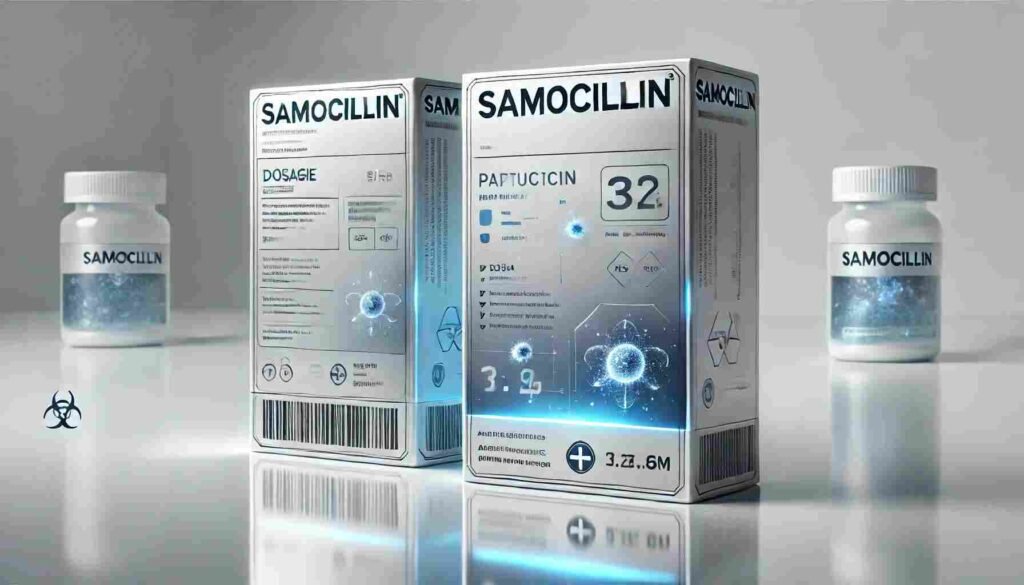Introduction
Samocillin is a widely recognized antibiotic used to treat various bacterial infections. As a member of the penicillin family, I know it’s designed to combat bacteria effectively, making it a go-to treatment for diseases like respiratory ailments, skin conditions, and more. With its proven track record, understanding Samocillin’s uses, dosage, and safety measures is crucial for patients and healthcare providers.
In this guide, we’ll cover everything you need to know about Samocillin, from its benefits and side effects to frequently asked questions and safety tips.
What is Samocillin?
Samocillin is a broad-spectrum antibiotic that belongs to the penicillin class. It’s designed to treat bacterial infections by inhibiting the growth of bacteria, thereby preventing the spread of the disease. Samocillin is often prescribed for common diseases such as:
- Respiratory tract infections (e.g., bronchitis, pneumonia)
- Skin infections (e.g., cellulitis, impetigo)
- Urinary tract infections (UTIs)
- Ear infections (e.g., otitis media)
- Throat infections (e.g., tonsillitis, pharyngitis)
How Does Samocillin Work?
Samocillin targets the bacterial cell wall, disrupts its synthesis, and kills the bacteria. This process helps prevent the infection and enables the body’s immune system to remove the remaining bacteria.
- Bactericidal Action: It kills bacteria rather than just inhibiting their growth, making it highly effective for treating active infections.
- Spectrum of Activity: While primarily effective against Gram-positive bacteria, Samocillin can also target some Gram-negative strains, offering broad protection.
Uses and Benefits of Samocillin
Samocillin’s effectiveness makes it suitable for a range of bacterial infections. Here’s a closer look at its primary uses and benefits:
Treats Respiratory Infections
Samocillin is commonly prescribed for respiratory infections, including bronchitis, pneumonia, and sinusitis. It reduces bacterial growth in the respiratory tract, helping relieve symptoms like coughing, difficulty breathing, and chest discomfort.
- Quick Relief: Patients often experience symptom relief within a few days of starting the treatment.
- Reduced Inflammation: It also helps reduce inflammation caused by bacterial infections, making breathing easier.
Effective for Skin Infections
Samocillin also effectively treats skin infections like cellulitis, impetigo, and abscesses. It targets the bacteria causing the infection, helping to clear up redness, swelling, and pain.
- Faster Healing: By targeting the bacteria at the site of infection, Samocillin promotes faster skin recovery.
- Prevents Spread: It helps prevent the spread of skin infections to other parts of the body.
Fights Urinary Tract Infections (UTIs)
Samocillin is sometimes used to treat urinary tract infections, especially those caused by susceptible bacteria. It reduces bacterial levels in the urinary system, helping to alleviate symptoms like pain during urination, frequent urination, and lower abdominal discomfort.
- Reduces Pain: Alleviates discomfort associated with UTIs.
- Promotes Recovery: Helps clear the infection more effectively when taken as prescribed.
Pediatric and Adult Use
Samocillin is suitable for adults and children, making it a versatile option for treating infections across age groups. Although the dosage varies based on age, weight, and disease severity, it generally offers safe and effective treatment for all patients.
- Adjustable Dosing: The medication can be tailored to different age groups and infection severities.
- Well-Tolerated: It’s typically well-tolerated with minimal side effects when used correctly.
Dosage and Administration of Samocillin

The correct dosage of Samocillin is crucial to ensure its effectiveness and reduce the risk of side effects. Always follow your healthcare provider’s instructions when taking Samocillin.
Standard Dosage Guidelines
- Adults: The usual dosage ranges from 500 mg to 1,000 mg every 8 hours, depending on the severity of the infection.
- Children: Dosage for children is based on body weight, typically around 20-40 mg/kg/day, divided into three doses.
Potential Side Effects of Samocillin
Like all medications, Samocillin can cause side effects, though not everyone experiences them. It’s essential to be aware of potential side effects and take appropriate measures if they occur.
Common Side Effects
- Nausea and Vomiting: Mild gastrointestinal issues are common but usually subside over time.
- Diarrhea: Loose stools may occur, especially during the first few days of treatment.
- Rash: A mild rash can develop and typically resolves independently.
Serious Side Effects
While rare, serious side effects may require immediate medical attention:
- Allergic Reactions: Symptoms like hives, difficulty breathing, and swelling of the face or throat may indicate a severe allergic reaction.
- Severe Diarrhea: Persistent or bloody diarrhoea could indicate a more serious intestinal condition called Clostridium difficile-associated diarrhoea.
- Liver Issues: Yellowing of the skin or eyes, dark urine, or severe fatigue may indicate liver problems.
FAQs About Samocillin
Is Samocillin effective against all bacterial infections?
No, Samocillin is effective against certain types of bacteria, primarily Gram-positive strains. A bacterial culture test is essential to determine its suitability for specific infections.
Can I take Samocillin if I’m allergic to penicillin?
If you have a known penicillin allergy, you should avoid Samocillin, which belongs to the penicillin class and may trigger an allergic reaction.
How long does it take for Samocillin to work?
Samocillin generally starts to work within a few days. However, completing the prescribed course is crucial the prescribed course.
Can I drink alcohol while taking Samocillin?
It’s best to avoid alcohol while taking Samocillin, as it may increase the risk of side effects like stomach upset, dizziness, and impaired immune response.
Is Samocillin safe for children?
Yes, Samocillin is generally safe for children when dosed appropriately. Consult a paediatrician for the correct dosage based on the child’s weight and age.
Conclusion
Samocillin is a powerful and versatile antibiotic that effectively treats many bacterial infections. You can use it safely and effectively by understanding its uses, proper dosage, and potential side effects.
Always follow your healthcare provider’s instructions and complete the entire course of treatment to ensure the best outcomes. With its broad-spectrum action and proven effectiveness, Samocillin remains a trusted option in the fight against bacterial infections.
Latest Post!
- Leah Gettens: A Journey of Dedication, Talent, and Success
- Florian Hartenstein: A Journey of Passion, Talent, and Success
- Unlock Premium Features on Castle App: A Comprehensive Guide
- Quintin Conway Obituary: Celebrating a Life Full of Memories
- FlixHQBZ Originals: A New Era of Exclusive Streaming Content
- Hurawatch.bz: A Safe and Seamless Streaming Guide for 2024






